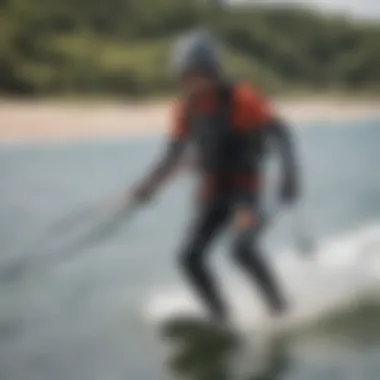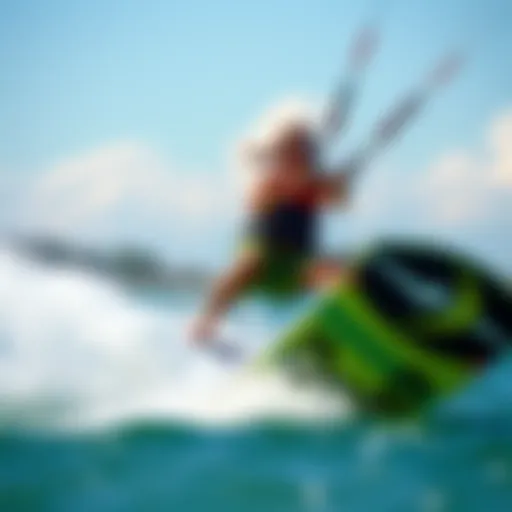Exploring the Waist Leash for Kiteboarding Success


Intro
In the world of kiteboarding, understanding the gear you use is as crucial as mastering the techniques on the water. One component that often flies under the radar yet plays a pivotal role in both safety and performance is the waist leash. This guide explores everything you need to know about waist leashes, from their function to their significance, especially when it comes to kiteboarding.
Kiteboarding can be exhilarating, but it's not without its hazards. A waist leash not only keeps the kite attached to you but also provides more flexibility compared to other leash types. With the right knowledge, kiteboarders can optimize their experience and improve their safety on the water. So, let's dive into the gear insights, techniques, tips, and best practices surrounding waist leashes.
Gear Insights
When it comes to kiteboarding, the right gear makes all the difference. Among these, waist leashes stand out for their unique functionality and advantages.
Latest Gear Reviews
There’s a myriad of options available in the market today. Here’s a closer look at some popular waists leashes:
- Mystic Star Waist Leash – Known for its durable construction. It features a quick-release mechanism, enhancing safety.
- Naish 2023 Waist Leash – Offers excellent flexibility, ideal for advanced maneuvers.
- Cabrinha Leash – With a lightweight design, this is perfect for reducing drag while riding.
Every kiteboarding session can benefit from selecting the right waist leash. Ensure it matches your level, style, and personal preferences.
Essential Gear for Beginners
For those just starting on their kiteboarding journey, having the right equipment is essential. Apart from a waist leash, consider investing in:
- A reliable kite suitable for beginners, like the Slingshot Z Kite.
- A set of appropriate bindings tailored to your foot size.
- A comfortable impact vest for safety during falls.
Your first kiteboarding experience should be enjoyable without unnecessary mishaps. Grabbing the right gear can make that happen.
"The right gear not only enhances your experience but ensures safety — which in kiteboarding, is non-negotiable."
Techniques and Tips
Being equipped with the right gear is just half the challenge. The rest lies in mastering techniques and ensuring your safety while kiteboarding.
Advanced Tricks and Techniques
Once you’re comfortable with kiteboarding basics, elevating your skills to perform advanced tricks requires practice and patience. Some tricks to master include:
- Jumping with the Kite – Focus on timing your pull and edging perfectly.
- Handle Pass – This involves passing the bar behind your back while in mid-air.
- Backroll – A classic move where the rider rotates backward.
Proficiency in these tricks not only amplifies your riding style but also boosts your confidence on the water.
Safety Practices for Kiteboarders
Safety should always be at the forefront. Here are essential safety practices:
- Make sure to always wear a helmet and impact vest.
- Know your surroundings—avoid crowded areas and respect local regulations.
- Practice using the quick-release features on your waist leash. This can be life-saving in an emergency.
By keeping safety in mind, your kiteboarding sessions transform into more enjoyable adventures without the anxiety of potential risks. The perfect combo of knowledge, the right gear, and safety practices is non-negotiable for an optimal kiteboarding experience.
Ending
Mastering the art of kiteboarding goes hand-in-hand with understanding your equipment, especially the waist leash. By choosing the right gear and practicing essential techniques and safety measures, both newcomers and seasoned kiteboarders can enjoy exhilarating experiences on the water. Remember, kiteboarding is not just about the thrill, but also about making informed decisions that ensure safety and enhance performance.
Understanding the Waist Leash
In the realm of kiteboarding, the waist leash is more than just an accessory; it’s a pivotal component that can significantly dictate the overall experience on the water. Understanding this piece of equipment is essential not only for beginners but also for seasoned kiteboarders looking to enhance their performance. Employing the right waist leash can bolster safety, improve maneuverability, and expand the range of tricks a rider can perform. Thus, diving into the functionalities and nuances of the waist leash provides valuable insights for effective kiteboarding.
Definition and Purpose
A waist leash is a specialized tether used to secure a kiteboarder to their kite via the harness worn around the waist. Unlike traditional leash designs, which may attach to the wrist or ankle, the waist leash functions with the intention of maximizing freedom of movement while maintaining control over the kite.
Its primary purpose is to keep the kiteboarder connected to their kite while allowing for greater mobility. This configuration is particularly advantageous during tricks or when navigating challenging wind conditions. The waist leash also provides a critical lifeline — when deployed correctly, it ensures that even in the unfortunate event of a fall or disconnection, the kite remains within the rider's control, significantly reducing the risk of injury or loss.
How it Functions
The operation of a waist leash is relatively straightforward but involves various components that work collectively to enhance user experience and safety. When set up properly, the waist leash connects through a quick-release mechanism on the harness, allowing for easy disconnection in emergencies.
- Attachment Point: Attached to the harness, the leash stretches across the back and fastens to the kite’s safety system. This connection allows the kiteboarder to freely move without constantly worrying about tethering the kite.
- Length and Flexibility: Waist leashes typically come in multiple lengths, accommodating different styles of riding. Most feature elastic cords that allow for flexibility while providing enough resistance to keep the kite controlled during rides.
- Reconnection Mechanism: Should a rider lose the connection, the leash is designed to allow for a quick reconnection. Whether it’s a planned release during a trick or an unintentional detachment due to a tumble, modern designs prioritize user-friendly functionality.
Remember, a poorly maintained or incorrectly used waist leash can transform into a liability rather than an asset. Therefore, understanding its intricacies is crucial for safety and enjoyment on the water.
"The effectiveness of a waist leash goes beyond its design; it intertwines with the rider’s skill and focus, ultimately shaping their experience in kiteboarding."
The significance of the waist leash encompasses various dimensions of the kiting experience, emphasizing the importance for every kiteboarding enthusiast to comprehend its role and dynamics thoroughly.
Historical Context
Understanding the historical context of the waist leash is pivotal for kiteboarding enthusiasts. It situates the evolution of the sport within a broader narrative of technological advancements and gear development. This perspective not only enriches the practitioner’s knowledge but also highlights the innovations that have shaped kiteboarding today.
Evolution of Kiteboarding Gear
Kiteboarding has journeyed through a fascinating evolution since its conceptual inception in the late 20th century. In the beginning, equipment was pretty rudimentary. Early boards were often homemade and kites were basic, resembling large, inflatable structures that lacked the stability and control modern versions possess.
As the sport gained popularity, manufacturers began refining designs with more attention to materials and performance. Fiberglass and later carbon fiber materials transformed board construction. Kites evolved significantly, transitioning from inflatable designs to more streamlined, user-friendly shapes, allowing for better control in diverse wind conditions.
The addition of safety features was also not just an afterthought but a necessity. Early kiteboarders faced high risks of accidents due to gear that would often malfunction or behave unpredictably. The creation of systems like the quick-release mechanism not only made the sport safer but also marked a turning point in design priorities across the industry.
This journey holds a significance that goes beyond mere functionality. When enthusiasts understand the challenges faced by early practitioners and the pioneering solutions introduced, it cultivates a deep appreciation for the gear they use today.
The Preface of the Waist Leash
The waist leash emerged as a revolutionary piece of equipment in kiteboarding. Prior to its introduction, kiteboarders relied heavily on wrist leashes, which, while functional, had several drawbacks. These wrist leashes could easily lead to entanglement, especially in tricky situations, presenting real hazards for riders.
The waist leash was designed to address these issues. Its unique positioning allows for a higher degree of freedom of movement, significantly enhancing the rider's ability to maneuver. More seasoned kiteboarders found that the waist leash also offered an improved connection to the kite, translating movements more effectively than wrist-mounted alternatives.


Moreover, with an adjustable length and comfort features, the waist leash quickly gained traction among both casual riders and professionals. Its design evolves continually, reflecting user feedback and advances in materials. What started as a simple safety device has become an integral part of kiteboarding gear, often favored for its balance of safety and agility.
As kiteboarding continues to see innovations, the waist leash stands as a testament to how gear can evolve in response to the needs of its users, ultimately shaping the riding experience for better or worse.
Types of Waist Leashes
When discussing kiteboarding, one of the pivotal elements that can significantly influence a rider's experience is the waist leash. As such, a proper understanding of the different types of waist leashes available can serve kiteboarders well—whether they are novices eager to learn the ropes or seasoned hands seeking to optimize their gear. The selection of a waist leash impacts everything from safety and comfort to performance on the water.
Basic Designs
Basic designs of waist leashes generally revolve around a straightforward concept, aiming to provide reliable functionality without excessive frills. These leashes typically feature a sturdy cord attached to a waist belt, allowing for easy retrieval of the board in case of a fall. One of the standout traits of these designs is their simplicity, which often translates into durability, an essential quality when navigating the waves.
In these basic setups, you might spot materials like nylon or polyester, which are both resilient and relatively easy to care for. The length of the leash, meanwhile, could typically range from 3 to 5 feet, which is adequate for most riding conditions.
Important Considerations:
- Durability: Basic designs need to stand up to the rigors of ocean conditions. Look for UV-resistant materials.
- Weight: Lightweight options enhance movement, which can be crucial for maneuverability.
"A reliable basic leash can be more effective than a fancy one if it fits your style and conditions!"
Performance-Oriented Options
These leashes cater to a more advanced audience. Performance-oriented waist leashes are tailored for kiteboarders who are looking to push their limits. Often made from advanced materials such as Dyneema, these leashes come equipped with features designed to enhance responsiveness and reduce drag.
One prime example is a leash that incorporates a quick-release mechanism, allowing the rider to disengage swiftly from the board in emergencies. Another notable feature is the integrated safety systems designed to minimize entanglement risks. Such options tend to be slightly stiffer, allowing for better control in challenging conditions.
Key Points:
- Material: Lightweight yet robust fibers can improve performance.
- Quick-Release: This feature can be a lifesaver.
- Minimal Drag: Critical for high-speed riding conditions.
Specialized Features
Some waist leashes come with specialized features that can significantly impact the kiteboarding experience. These could range from built-in flotation devices to leashes designed specifically for unique styles of riding, such as freestyle or foiling.
A specialized leash may include added padding for improved comfort, especially during long sessions. Some advanced models offer adjustable lengths, allowing flexibility based on user preference or riding style. Moreover, brands often experiment with different attachment styles, including magnetic closures or innovative buckle designs that enhance usability.
Elements of Specialty Leashes:
- Comfort Padding: Essential for extended use.
- Adjustability: Flexibility to cater to changing conditions or riding styles.
- Unique Attachments: Enhances ease of use, particularly in swift conditions.
Benefits of Using a Waist Leash
The waist leash—an often overlooked piece of kit—brings several significant advantages to kiteboarders of all skill levels. Understanding these benefits can not only enhance your kiteboarding experience but also influence your overall safety on the water. Let's look at some of the most compelling reasons to opt for a waist leash over other designs.
Increased Freedom of Movement
One of the most striking benefits of using a waist leash is the increased freedom it offers. Unlike traditional ankle leashes, which can sometimes restrict your motions and create drag, the waist leash allows for a broader range of movements. This is particularly important during sudden maneuvers or changes in direction. Kiteboarders can twist and turn without being hindered, making for a more fluid riding style.
When you let go of the bar or need to release during a wipeout, the leash stays comfortably around your waist. This setup means you can dive back into the action more swiftly, minimizing your time away from the thrill. The diminutive drag factor coupled with the comfort of the waist attachment allows kiteboarders to feel freer, translating into higher performance on the water.
Enhanced Safety Features
Safety is a key consideration for any kiteboarding enthusiast. Using a waist leash can significantly enhance safety, primarily due to its design and positioning. The waist leash typically features a quick-release system that allows for instant detachment in emergencies. Should you find yourself in a precarious situation—perhaps due to a gust of wind or an unexpected dip into the water—a swift release could mean the difference between a minor hiccup and a more serious incident.
Additionally, the waist leash helps mitigate the risk of entanglement. Traditional leashes can become twisted or caught, posing a danger when you're up against the elements. A waist leash lets the rider maintain a better awareness of the connection between their body and the kite, thus reducing chances of entanglement or accidents caused by floppy excess line. Importantly, this setup allows for smoother disengagement should you need to swim back to your board or make a hurried retreat to shore.
Compatibility with Other Gear
Another noteworthy aspect of waist leashes is their compatibility with various types of kiteboarding gear. While some leashes may limit options, waist leashes can be integrated seamlessly with many harness designs. The flexibility they offer means that whether you're using a seat harness or a standard waist harness, the leash will work without any hassle.
This interoperability extends to your kite setup as well. Many advanced kiteboarders appreciate how a waist leash can adapt to different kite sizes and styles, making it easier to transition among various setups without needing to switch out accessories. This versatility enables hobbyists and professionals alike to streamline their equipment without compromising on safety or performance.
In summary, the waist leash brings distinct advantages that enhance freedom of movement, bolster safety, and ensure compatibility with other gear. Understanding these benefits is vital for anyone looking to elevate their kiteboarding experience. The waist leash isn't just another accessory; it’s a fundamental element that might redefine how you approach kiteboarding.
Potential Drawbacks
While the waist leash offers numerous benefits for kiteboarders, like any piece of equipment, it's not without its drawbacks. Understanding these potential pitfalls is crucial for anyone looking to optimize their kiteboarding experience. A well-informed rider can not only enhance their safety but also ensure that they maximize their enjoyment on the water. This section delves into two significant concerns: the risk of entanglement and discomfort during extended use.
Risk of Entanglement
One of the foremost considerations when using a waist leash is the risk of entanglement. When kiteboarding, a sudden gust of wind or an unexpected maneuver can cause the leash to become tangled in your harness, lines, or even the kite itself. This situation can lead to dangerous scenarios, particularly for beginners still mastering their operations. While it may seem like a minor issue, entanglement can lead to loss of control, putting the rider at significant risk.
Entanglement doesn't just affect the rider's control; it can also impact others in the vicinity. For example, if you were to tumble in the water but remain tethered to your kite through a tangled leash, this can create a hazard for fellow kiteboarders who may be nearby. To mitigate these risks, it’s advisable to practice with the leash in calm conditions before venturing into more challenging waters.
Tips to minimize entanglement:
- Practice in Safe Conditions: Learn how to manage your leash before hitting rougher waters.
- Regularly Inspect Equipment: Check your lines and leash for wear and tear. A frayed line can contribute significantly to unfortunate entanglements.
- Be Mindful of Your Movements: Avoid making sudden turns while the kite is at lower angles. This could ease the chance of entanglement, giving you more control.
"A rider is only as good as the preparation they undertake. Anticipation helps avoid mishaps on the water."
Discomfort during Extended Use
Another noteworthy drawback relates to the discomfort some riders experience during extended periods of kiteboarding. This discomfort can stem from several factors including harness fit, leash design, and the material used in the construction of the waist leash itself. Hours spent harnessed to a kite can lead to chafing, irritation, or, in severe cases, cause even longer-term physical issues.
Here are a few aspects to keep in mind:
- Harness Fit: An improperly fitted harness can exacerbate discomfort. Ensure that your harness is adjusted correctly, sitting flush against your body and providing adequate support without pinching or causing friction.
- Leash Material: Some waist leashes are constructed from stiffer materials, which may not flex or stretch adequately with body movement. Choosing a leash that allows for freedom of motion while providing support can make a world of difference.
- Breaks and Stretching: During extended sessions, take regular breaks to stretch. This not only alleviates physical discomfort but also helps prevent over-tiring your muscles.
Choosing the Right Waist Leash
Choosing the right waist leash is not merely a matter of preference; it is essential for optimizing your kiteboarding experience. A well-chosen leash enhances your mobility, ensures safety during intense sessions, and complements your style as a rider. With so many varieties in the market, it's essential to identify what will support your needs most effectively. You wouldn't want to be caught in the middle of a thrilling ride with a leash that’s either too short or lacking in durability.
Factors to Consider
Material Quality


When it comes to material quality, you want a waist leash that stands the test of time and the rigors of kiteboarding. Common materials include robust nylon and soft neoprene. These materials shine in their own ways. Nylon is widely recognized for its exceptional strength, making it resistant to abrasions and tears. On the flip side, neoprene offers a soft and flexible fit which increases comfort during long sessions.
- Key Characteristic: Nylon is tough, while neoprene brings comfort.
- Popular Choice: Choosing a leash with nylon where it counts can provide peace of mind – especially when fighting against the elements.
- Unique Feature: The combo of strength in nylon and softness in neoprene allows riders to benefit from both durability and comfort.
Length and Adjustability
A leash's length and how well you can adjust it can dramatically affect how you ride. Some riders prefer a longer leash for freedom, while others might feel more secure with a shorter option. An adjustable leash brings flexibility to the table.
- Key Characteristic: Adjustable waist leashes allow for personalized fit, accommodating different riding styles and preferences.
- Beneficial Choice: This ability to customize can enhance stability while maneuvering and performing tricks in the water.
- Unique Feature: The ability to adjust the leash length can limit the risk of entanglement while still providing the freedom you need.
Ultimately, understanding length and adjustability can help you make an informed decision on what works best for your kiteboarding needs.
User Reviews
User reviews should never be overlooked. They give you insight into others' experiences, helping you see which products live up to their claims.
- Key Characteristic: Reviews often cover vital aspects such as durability, functionality, and ease of use.
- Popular Choice: Many buyers rely on experienced kiteboarders’ opinions to gauge which leashes consistently perform better in various conditions.
- Unique Feature: Taking into account detailed reviews allows potential buyers to avoid pitfalls, like poorly designed models or those that don’t hold up against wear and tear.
Before making that all-important purchase, spending some time reading user reviews can set you on the right path and save you from costly mistakes.
Balancing Price and Functionality
Finding the sweet spot between price and functionality is crucial. A more expensive leash might offer advanced materials and features, but you also need to assess whether those extras are necessary for your riding style.
- Consider whether the premium features are worth the additional cost for your individual needs.
- Sometimes a mid-range option performs just as well as a high-end model without breaking the bank.
- Evaluate your budget alongside the technical specifications before making a final decision.
Ultimately, balancing price with functionality can lead to a satisfying purchase that serves you well on the water.
Installation and Setup
When kiteboarding, the setup of your equipment is as crucial as the gear itself. The waist leash plays an integral role in both performance and safety while you're out on the water. Getting this aspect right ensures you can enjoy the thrill of kiteboarding without unnecessary worries. Knowing how to install and set up your waist leash properly helps prevent mishaps and enhances your overall experience, optimizing both control and agility.
Step-by-Step Guide
Installing a waist leash involves a few simple steps, but they need to be done with care for effective results. Here’s how to do it:
- Choose the Right Location: Start by selecting a suitable spot on the waist or harness where the leash can be attached securely. This should typically be on the side, where it won’t interfere with your movements.
- Thread the Leash: Take the hook of the waist leash and thread it through the designated loop on your harness. Ensure it is fully through and that there is no slack.
- Fasten Securely: Pull the leash snugly and secure it using the mechanism provided, often a Velcro strap or a clasp. It should feel tight, but not overly restrictive.
- Adjusting Length: Depending on your preference and style, you may choose to adjust the length of the leash. Ensure it allows enough movement without being too long, which could risk tangling.
- Double Check: Finally, give everything a good look and ensure that all connections are secure. It is wise to perform a few tests before hitting the water to ensure your leash is set up as intended.
"A secure setup not only enhances enjoyment but also plays a crucial role in maintaining safety on the water."
Common Mistakes to Avoid
While the steps to install a waist leash are straightforward, mistakes can pop up, especially for newbies. Here are a few common pitfalls:
- Over-Adjusting: Some kiteboarders tend to adjust their leash too tightly, which can lead to discomfort or limited movement during riding. Aim for snugness, not excessive restriction.
- Ignoring Material Quality: Not all leashes are built the same. Choosing a poorly constructed leash can lead to failures, especially after repeated use. Look for durable materials that can withstand the stresses of kiteboarding.
- Poor Placement: Attaching the leash in an awkward position can result in tangling with other lines or your body. Always place it in a location that allows for free movement.
- Skipping Regular Checks: Don’t make the mistake of assuming your leash is reliable without a quick inspection. Regularly check for wear and tear, and replace it when necessary.
Whether you are a seasoned kiteboarder or just starting out, being cautious with your installation and mindful of potential pitfalls can directly affect your session. Make it a priority and enjoy the ride!
Safety Considerations
Kiteboarding is a thrilling sport, but along with the excitement comes a level of risk. Understanding the safety considerations surrounding waist leashes is paramount for anyone looking to enjoy this activity responsibly. This section focuses on recognizing the elements that can contribute to safer kiteboarding experiences through proper use of waist leashes.
Understanding Risks
Every kiteboarder needs to have their eyes wide open about the potential risks that come with using a waist leash. Imagine being caught in a sudden gust of wind and losing control— that’s where the leash plays a crucial role. However, if the leash gets tangled or improperly secured, it can lead to unwanted consequences.
Some common risks include:
- Entanglement: When a rider falls or wipes out, the leash can become tangled in the kite lines or around the rider’s limbs. This can impede movement and pose a significant danger.
- Pressure Injuries: Waist leashes might not distribute force evenly. In the event of a sudden rollback or misjudgment in a trick, the force can cause painful pressure or even bruises.
- Loss of Equipment: An unfastened or weakly secured leash can result in the loss of not just your board but your momentum as well; skimming across the water without equipment is far from the intended thrill.
It's vital for kiteboarders to regularly inspect their equipment and practice scenarios where the leash may come into play. Never underestimate the importance of familiarizing yourself with your gear— it can mean the difference between a great ride or a visit to the first-aid tent.
Emergency Procedures
Being prepared for emergencies is like having a life jacket when out at sea; it simply makes sense. When kiteboarding, knowing how to quickly react during mishaps can greatly improve safety. Here are some emergency tips to follow when something goes south:
- Stay Calm: The first instinct may be to panic, but staying level-headed allows you to assess the situation and act accordingly.
- Release the Leash: Familiarize yourself with the quick-release mechanism of your waist leash. Practice this on dry land until you are comfortable with it. In a situation where it's necessary to detach, you'll want it to be second nature.
- Signal for Help: If you find yourself in a tricky spot, don't hesitate to signal to fellow kiteboarders or a nearby boat for assistance. Most in the community will be quick to lend a hand.
- Know Your Surroundings: Be aware of your environment. Always keep an eye out for potential hazards like rocks, other riders, or strong currents. If you recognize challenging conditions, it may be wise to pack it up for the day.
"In a sport where the wind can control your fate, the key is to give yourself every advantage possible. Understanding both risks and emergency protocols can keep your kiteboarding adventures exciting, not alarming."
Maintenance and Care
A waist leash, just like a fine-tuned kite, needs regular maintenance and care to ensure it remains reliable and functional. Neglecting these crucial aspects can lead to diminished performance, safety risks, or even premature wear and tear. Taking time for proper maintenance of your leash is not just a good practice; it's a fundamental part of kiteboarding that every enthusiast should embrace. Here’s how you can keep your waist leash in top-notch condition.
Cleaning Techniques
Cleaning your waist leash is essential to extend its lifespan. After a session on the water, it is advisable to rinse it off with fresh water to remove salt, sand, and dirt. Here are some effective steps:
- Rinse Thoroughly: Use a hose or a bucket to rinse away any debris, particularly after a day at the beach when grit and salt can accumulate.
- Use Gentle Soap: If more than just rinsing is needed, a mild soap mixed with water can help. Make sure to avoid harsh chemicals, as they can break down the materials over time. A solution made of warm, soapy water should suffice.
- Scrubbing: For areas that have stubborn dirt, a soft brush can assist in loosening up grime without damaging the leash.
- Drying: After cleaning, lay the leash flat in a shaded area to avoid direct sun exposure which might degrade the materials. Avoid using direct heat sources like radiators or hair dryers, as they can cause warping or breakage.
Maintaining cleanliness helps prevent future damage and ensures your leash performs well when the wind picks up.
Storage Recommendations
Where and how you store your waist leash can significantly affect its longevity. Proper storage will not only keep the leash in good condition for your next adventure but also mitigate safety risks that can arise from damage. Here are some pointers for effective storage:
- Choose a Cool, Dry Place: Heat and humidity can deteriorate the materials of your leash over time. A cool, dry environment is optimal.
- Avoid Direct Sunlight: Storing your leash in sunlit areas, like the back of the car, can lead to fading and brittleness. Instead, aim for a shaded spot.
- Use a Designated Bag or Case: Invest in a storage bag specifically designed for kiteboarding gear. This will not only keep your leash organized but also protect it from potential snags or abrasions.
- Inspect Regularly: Incorporate checks during storage. Make it a habit to examine your waist leash for cracks or fraying at least once a month. Early detection can prevent accidents on the water.
Real-World Experiences
Navigating the waters of kiteboarding is as much about the gear as it is about the skills one brings to the table. The waist leash is no exception, as its performance can significantly influence a rider's experience. This section, dedicated to Real-World Experiences, illuminates how individual stories and insights shape our understanding of the waist leash's practical value. Whether you're a seasoned kiteboarder or still figuring out your first board, hearing from those in the trenches can give you valuable perspectives.
User experiences highlight not just the joys but also the pitfalls that come with using a waist leash. For instance, a common sentiment shared among kiteboarders revolves around the feeling of liberation that waist leashes provide. Riders articulate a sense of freedom of movement that traditional leash setups often constrain. This freedom translates to better maneuverability, allowing for more confident, spontaneous actions in the water.


However, it is crucial to underline that experiences vary. Factors like skill level, riding style, and personal comfort play significant roles. As you dive deeper into this topic, you’ll read particular stories that emphasize the importance of recognizing your own preferences, particularly when selecting gear that best suits your approach to kiteboarding.
User Testimonials
User testimonials serve as a reflection of the broader kiteboarding community's interactions with the waist leash. Consider the case of Jamie, a kiteboarding instructor who transitioned from a conventional harness setup to a waist leash just last summer. "At first, I was skeptical," Jamie admits. "But once I tried it, I was hooked. The waist leash allowed me to move without restrictions, which, in turn, made me feel more in tune with the kite and the water. I could jump higher and land smoother."
These personal accounts often resonate with many from the kiteboarding community. Testimonials can become a sort of community lore, furthering knowledge throughout the sport. Other riders echo Jamie's sentiments, stressing the benefits of reduced drag and improved responsiveness. They paint vivid pictures of riding effortlessly with friends, gliding over waves with a harmony that only a well-chosen leash can inspire.
Yet, testimonials also reflect the cautionary tales. Take Mark, who shared his experience of an unexpected entanglement with his waist leash while traveling at high speeds. "It totally caught me off-guard and made me realize that while these leashes offer more freedom, that freedom also comes with a responsibility. Knowing how to manage the leash properly and being aware of my surroundings has become critical for me since that incident."
Expert Insights
With a tapestry of user experiences, complementing this landscape are the insights of experts who have devoted their careers to the field of kiteboarding. These professionals often emphasize the scientific advances that inform today's waist leash designs. Dr. Anna Reynolds, an aerodynamics expert and kitesurfing enthusiast notes, "The evolution of materials used in waist leashes has led to enhancements in both flexibility and strength. Therefore, they’re not only practical but can be engineered for optimal safety today."
Experts also point to the importance of personal assessments. For many riders, the fit and comfort of the waist leash can be as vital as technical design. Renowned kiteboarding coach Jake Thompson urges riders to always test the fit before committing long-term. "A well-fitted waist leash can mean the difference between a flawless ride and an uncomfortable session that saps your energy. Comfort should never be secondary to performance."
When you combine personal testimonials with expert knowledge, it paints a comprehensive picture. The real-world experiences shed light on both the transformative impact and the potential risks of waist leashes. They empower current and future kiteboarders to make better-informed decisions and cultivate a deeper understanding of the gear they use in the vast ocean.
"At the end of the day, it’s about enjoying every moment on the water. Knowledge from those who’ve been there makes that pursuit a bit easier." - Anonymous Kiteboarder
In closing, the discussion around Real-World Experiences undoubtedly reveals that engaging with others' stories can enhance our understanding of the many facets of using a waist leash. Each story, each challenge faced, yields something of value that can aid both new and experienced kiteboarders alike.
Comparative Analysis
In the world of kiteboarding, selecting the right equipment can make or break your experience on the water. This is where the concept of comparative analysis comes into play as it equips enthusiasts with essential insights into the various options available. Understanding the differences between a waist leash and its alternatives offers a strategic advantage for kiteboarders of all skill levels. It highlights the pros and cons of each type, helping practitioners make well-informed decisions that align with their preferences and riding styles.
Engaging in a comparative analysis involves examining factors such as safety, comfort, adjustability, and performance attributes of each leash type. By weighing these considerations, kiteboarders can enhance their sessions, minimizing risks while maximizing enjoyment.
Waist Leash vs. Other Leash Types
When comparing the waist leash to other leash types, such as the traditional leg leash or the overhead leash, understanding the distinct functionalities can be quite revealing.
The waist leash attaches to the harness around your waist, providing a unique perspective on movement. This design facilitates increased freedom of motion because it allows you to shift your body without being tethered directly to your legs, which can sometimes restrict movement during maneuvers. Conversely, the leg leash, while simpler, fixes the connection to the lower body. This can lead to a situation where if you tumble or fall, the direct pull can be more jarring.
Here are some points for consideration:
- Freedom of Movement: The waist leash provides greater upper body mobility, allowing for more dynamic maneuvers.
- Drag and Resistance: A leg leash might cause more drag during fast turns or jumps compared to a waist leash, which typically stays closer to your center of gravity.
- Ease of Release: In emergencies, the waist leash usually allows for a quicker release strategy compared to other types, reducing the chance of entanglement.
Ultimately, while the waist leash offers distinct advantages like agility and rapid disengagement, there are also moments when a leg leash might suffice for those just starting out or practicing more basic techniques.
Choosing Based on Skill Level
Skill level plays a crucial role in deciding which leash is best suited to an individual's needs. For newcomers to kiteboarding, the specifics of their choice may hinge on comfort and simplicity rather than high-performance features. A traditional leg leash often provides a sense of familiarity and ease, helping beginners acclimate without feeling overwhelmed by complex configurations.
On the other hand, more experienced riders might find a waist leash particularly beneficial. It supports advanced techniques, allowing riders to experiment and push their limits with fluidity.
Consider these factors for skill-level-based selection:
- Beginners:
- Intermediate to Advanced:
- Comfort: A simpler leash setup offers a less intimidating start.
- Learning Curve: Easier equipment lays a better foundation for mastering kite control.
- Enhanced Performance: The waist leash opens doors for tricks and aerial maneuvers.
- Safety Features: Advanced riders may appreciate the ability to disengage quickly in unexpected situations.
By clearly identifying where you stand in your kiteboarding journey, you can make more thoughtful choices about leashes and gear, paving the way for a safer and more enjoyable experience on the water.
Future Trends
As the kiteboarding scene evolves, the importance of keeping an eye on future trends becomes paramount. The waist leash, once a simple safety apparatus, burgeons into a multifaceted component that can significantly influence user experience. Those who kiteboard, whether seasoned veterans or jubilant novices, must grasp how these advancements can enhance both performance and safety. Embracing changes and innovations in equipment allows riders to adapt better to varying conditions and improving overall enjoyment while minimizing risk.
Innovations in Design
The realm of innovation concerning waist leashes encapsulates a range of design features that focus on user comfort and functionality. One notable advancement is the use of materials that prioritize durability while maintaining lightweight properties. For instance, innovations incorporating reinforced stitching and high-tenacity nylon have become increasingly common. These elements not only enhance the lifespan of the leash but also improve its responsiveness in dynamic water conditions, a significant boon for the active kiteboarder.
Moreover, customization options have gained traction; brands are now creating waist leashes that cater to diverse riding styles. Riders can choose leash designs that reflect their personal style or adjust for various weather conditions. Addition of features like quick-release mechanisms and integrated tools can help riders respond more swiftly during emergencies, showcasing how product design is taking user safety to heart.
- Some key innovations to watch for:
- Lightweight, high-strength materials
- Customizable colors and lengths
- Integrated safety features
"The next generation of waist leashes are shaping up to be a game-changer in the kiteboarding world, offering options that improve both usability and security."
The Impact of Technology on Safety
As technology permeates every aspect of our lives, its impact on safety within the kiteboarding sector cannot be overstated. Waist leashes have witnessed an infusion of tech—the integration of smart devices and feedback systems into traditional equipment. For example, some prototypes are currently in development, which can detect abnormal tension and alert the rider via a smartphone app. Such advancements are paving the way for a new era of proactive safety measures.
Additionally, the introduction of materials that absorb and dissipate shock can mitigate the risks associated with sudden jolts, common when high winds are involved. Improved buoyancy features can also ensure that leashes remain visible in water, which adds another layer of safety during retrievals or emergencies.
The convergence of high-tech solutions with classic designs also emphasizes the importance of user education. Riders must stay informed about these advancements, as knowledgeable usage can dramatically enhance their overall experience and safety while kitesurfing. Engaging with the community through platforms such as Reddit can be a valuable method for sharing experiences regarding new safety gear and innovations.
In summary, as kiteboarding continues to progress, the implications of both design innovations and technological enhancements are transforming the waist leash landscape. Recognizing these trends not only prepares kiteboarders for what lies ahead but also empowers them to select the right equipment that aligns with their riding style and safety needs.
Epilogue
In this guide, we have journeyed through the intricate landscape of the waist leash—a tool that plays a pivotal role in kiteboarding. Understanding its functionality and nuances is vital for anyone looking to enhance their kiteboarding experience. The waist leash not only amplifies one’s freedom of movement but also brings an array of safety features to the forefront, proving to be essential gear for both novice and seasoned kiteboarders.
Summary of Key Points
Throughout the sections, we discussed the following key points:
- Definition and Purpose: The waist leash serves to connect the kite to the rider, offering a balance between maneuverability and safety.
- Types of Waist Leashes: Various designs cater to different preferences and skill levels, which include basic designs, performance-oriented options, and specialized features.
- Benefits: Users benefit significantly from increased freedom of movement, enhanced safety, and compatibility with various gear.
- Potential Drawbacks: While waist leashes are advantageous, it’s important to understand the risks of entanglement and potential discomfort with prolonged use.
- Installation and Setup: A proper installation process and common mistakes to avoid were emphasized to ensure user safety and effectiveness.
- Real-World Experiences: Testimonials and insights from experts provided practical perspectives on the selection and use of waist leashes.
- Future Trends: Innovations in design foreshadow a more intuitive integration of technology, further enhancing safety.
The information amassed here serves to solidify understanding for both beginner and experienced kiteboarders, enabling them to select the right equipment.
Final Thoughts on Waist Leash Selection
When it comes to selecting a waist leash, it goes beyond just picking a product off the shelf. Consider personal comfort, your style of kiteboarding, and typical conditions you'll encounter. A leash may seem like a small accessory, but the right choice can offer comfort and performance improvements that are significant.
Remember, choosing the right waist leash also intertwines with understanding your limits, preferences, and how you wish to engage with the water. Having insightful recommendations at your disposal can make all the difference.
By keeping abreast of innovations and remaining diligent in maintenance, your experiences in kiteboarding can be both exhilarating and safe. We hope this guide aids you in maximizing your time on the water, encouraging you to try out different styles and options to find what works just for you. Kiteboarding is not just a sport; it's an adventure waiting to unfold.















